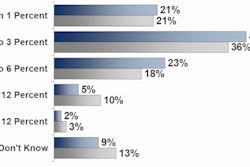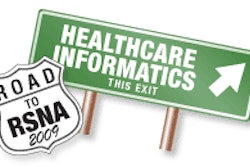CHICAGO - In conjunction with its annual meeting, the RSNA has published a free downloadable library of radiology report templates representing the "best-practice" recommendations of more than 100 experts from 12 radiology specialties. More than two years in development, the radiology report templates represent an initiative launched in 2007 to identify and promote excellence in radiology reporting.
Dr. Curtis Langlotz, chairman of the RSNA Structured Reporting Subcommittee and professor and vice chair for informatics in the department of radiology at the Hospital of the University of Pennsylvania in Philadelphia, described the project in a standing room only session on Tuesday. Langlotz has been a leading advocate of the need to standardize radiology terminology , and chaired the RSNA RadLex Steering Committee for its first six years of developing an ontology of more than 30,000 terms representing a single uniform radiology-specific lexicon.
In 2007, representatives from the RSNA met to discuss what it might mean to adopt commonly utilized reporting methodologies that would enable radiologists to use a narrative document designed and produced to maximize their efficiencies. The meeting participants recognized that both technological and economic factors changing the practice of medicine are impacting the expectations of a radiology report: that it be accurate, thorough and complete, that turnaround time be expedited and fast, that cost of producing the report be reduced, and that the report be in a format to facilitate data mining.
A Structured Reporting Subcommittee was established with the mandate to evaluate and develop reporting systems, processes, and tools that enable radiology information to be captured, stored, and presented in a clear, organized and consistent format.
The subcommittee decided that developing best practice templates based on the most commonly ordered examinations in twelve specialty areas would provide a guideline for content and help establish a standard with respect to what specific exam reports should contain, and recommend a standardized report format.
In 2009, radiologists are facing even greater pressure to provide reports that conform to standards. Langlotz identified five key forces, including consistency of report format and content; compliance with accreditation requirements, including documentation of critical results reporting; national compensation for pay incentives, and continuous quality improvement programs.
"You can’t improve what you can’t measure. This is easier to do in a structured report rather than free text," Langlotz said. He noted that many different peer-review published studies have proven that radiology report data captured in structured form improves report readability, and facilitates many radiology processes including order entry and automated billing. Structured reporting also supports analysis of radiology information for decision support, quality improvement, and research.
Structured reporting software development is still in its infancy, and a serious disadvantage for reporting radiologists is the need to move their eyes from viewing images to viewing the computer screen displaying the structured report. Utilization of speech recognition software can make the process easier.
The template format developed by the committee includes sections for radiology department administrative data, patient demographics, clinical history, imaging techniques, comparison studies, observations and comments, a summary or impression, and a signature.
It is not, however, a standard, Dr. Charles Kahn Jr., professor of radiology and chief of its division of informatics at the Medical College of Wisconsin in Milwaukee, emphasized. "The term ‘best practice template’ is being used deliberately, because the templates have not gone through national standards approval," he explained.
"They contain elements that we believe are important for each specific report. However, it is up to a radiology practice or department to determine if they wish to adopt some or all of them, and how they may wish to modify them," Kahn said.
The RSNA Structured Reporting Subcommittee expects to produce an additional 70 new templates in 2010, and is hoping to receive content from individual country’s radiology societies in their national languages. Anticipating large-scale expansion, a digital library infrastructure has been developed that will enable users to search templates by language, topic, RadLex codes, and by two-letter content codes.
The templates may be accessed and downloaded at reportingwiki.rsna.org or from the rsna.org Web site under the menu category "Informatics."
"Radiology reporting is rapidly evolving, because radiology reports are being used for many different purposes. They are now being used to drive billing, for quality control and peer review, and for both hospital and government data mining," Kahn said.
Reports today may be configured using a variety of supplemental multi-media information, including images, advanced visualization animation, and links to articles and educational references. Kahn predicts that in five to ten years, once a single radiology report is completed, it will automatically morph into multiple formats: for the radiology record, for the general practitioner, for specialists, for emergency physicians, and for the patient.
Structured reporting in use
Radiology departments can successfully adopt structured reporting. Dr. Ella Kazarooni, professor of radiology and director of the division of cardiothoracic radiology of the University of Michigan Health System in Ann Arbor, initiated a program for her division to start using structured reporting templates. She described day-to-day experiences.
"We got started about six to seven years ago with cardiac CT exam templates. Our cardiologists were used to having quantitative information and reports in a consistent format, similar to reports of echocardiograpy, perfusion imaging, and cardiac catheterization. We met with the cardiologists to determine what they wanted, and they wanted the same information in the same report location," Kazarooni said.
Over the past 18 months, more than 30 cardiothoracic templates have been developed for CT and x-ray procedures. They include standardized terminology, content where applicable, such as a description of the protocol, and format. A template has been developed for each exam protocol used by the department. MRI templates are currently in development.
Kazarooni explained that one of the ways she got radiologist buy-in was by promoting the fact that clinical information from the hospital’s radiology information system automatically populated report fields. "My colleagues would not have to type the patient’s history anymore, and this was a little bit tantalizing. Some thought that this would help improve their efficiency," she said.
She also said that the cardiothoracic division agreed in concept with the fact that standard operating procedures and protocols are utilized for every aspect in radiology to reduce variation and improve quality and efficiency. The exception was radiology reporting.
"To maintain uniform quality, we developed disease or protocol specific prompts. If someone is reporting the results of a CT chest exam, we want it to include specific details. If someone is interpreting a study of a patient with lung cancer, we want to make certain that certain details, such as tumor spread, metastases and lymph node enlargement are specifically mentioned, and that people can’t opt out of reporting these. If a radiologist in the department has the option to opt out of providing specific content, then the physician receiving our report doesn’t know if we didn’t look, or didn’t see, these details," Kazarooni explained.
References to guidelines and recommendations are also included in some templates for referring physicians. This information provides justification of recommendations made, including follow-up procedures, as well as caveats.
Checklists are utilized, and help maintain quality control by keeping radiologists on track when they are interrupted. This improves the overall quality, because nothing gets overlooked.
For normal exam findings, the adoption of structured reporting templates has significantly increased efficiency. Barcode, confirm normal and sign; the defaults throughout the template are normal.
Kazarooni would like to see the development of software integration of data from the modality and the RIS that would prefill additional fields. Vendors need to make it easier to import acquired data into the templates. And when a series of consecutive examinations have the same data, there should be a command that allows content in specific fields to be transferred.
But overall, structured reporting has been a success with Kazarooni’s department. The structured report template supports their brand identity, she said. The reports look visually consistent, contains consistent content, and because of this, the physicians who order them know what to expect. The referring physicians and the nurses who use them are very pleased, she said.
By Cynthia E. Keen
AuntMinnie.com staff writer
December 2, 2009
Related Reading
U.K. specialists want relevancy, detail in radiology reports, April 10, 2009
Voice recognition key to fast report turnaround, April 24, 2008
Speech recognition and structured reporting bring advantages, drawbacks, May 12, 2008
Meeting the challenge of structured reporting, June 23, 2006
RSNA’s RadLex initative gathers momentum, December 27, 2002
Copyright © 2009 AuntMinnie.com



















